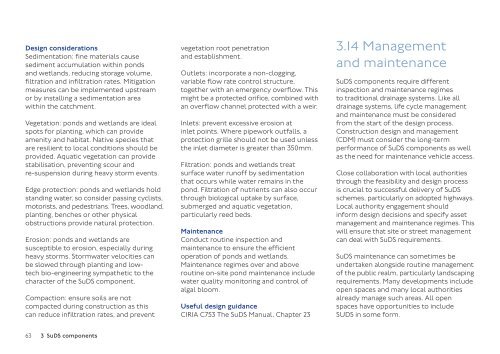SuDS in London - a guide
sustainable-urban-drainage-november-2016
sustainable-urban-drainage-november-2016
Create successful ePaper yourself
Turn your PDF publications into a flip-book with our unique Google optimized e-Paper software.
Design considerations<br />
Sedimentation: f<strong>in</strong>e materials cause<br />
sediment accumulation with<strong>in</strong> ponds<br />
and wetlands, reduc<strong>in</strong>g storage volume,<br />
filtration and <strong>in</strong>filtration rates. Mitigation<br />
measures can be implemented upstream<br />
or by <strong>in</strong>stall<strong>in</strong>g a sedimentation area<br />
with<strong>in</strong> the catchment.<br />
Vegetation: ponds and wetlands are ideal<br />
spots for plant<strong>in</strong>g, which can provide<br />
amenity and habitat. Native species that<br />
are resilient to local conditions should be<br />
provided. Aquatic vegetation can provide<br />
stabilisation, prevent<strong>in</strong>g scour and<br />
re-suspension dur<strong>in</strong>g heavy storm events.<br />
Edge protection: ponds and wetlands hold<br />
stand<strong>in</strong>g water, so consider pass<strong>in</strong>g cyclists,<br />
motorists, and pedestrians. Trees, woodland,<br />
plant<strong>in</strong>g, benches or other physical<br />
obstructions provide natural protection.<br />
Erosion: ponds and wetlands are<br />
susceptible to erosion, especially dur<strong>in</strong>g<br />
heavy storms. Stormwater velocities can<br />
be slowed through plant<strong>in</strong>g and lowtech<br />
bio-eng<strong>in</strong>eer<strong>in</strong>g sympathetic to the<br />
character of the <strong>SuDS</strong> component.<br />
Compaction: ensure soils are not<br />
compacted dur<strong>in</strong>g construction as this<br />
can reduce <strong>in</strong>filtration rates, and prevent<br />
vegetation root penetration<br />
and establishment.<br />
Outlets: <strong>in</strong>corporate a non-clogg<strong>in</strong>g,<br />
variable flow rate control structure,<br />
together with an emergency overflow. This<br />
might be a protected orifice, comb<strong>in</strong>ed with<br />
an overflow channel protected with a weir.<br />
Inlets: prevent excessive erosion at<br />
<strong>in</strong>let po<strong>in</strong>ts. Where pipework outfalls, a<br />
protection grille should not be used unless<br />
the <strong>in</strong>let diameter is greater than 350mm.<br />
Filtration: ponds and wetlands treat<br />
surface water runoff by sedimentation<br />
that occurs while water rema<strong>in</strong>s <strong>in</strong> the<br />
pond. Filtration of nutrients can also occur<br />
through biological uptake by surface,<br />
submerged and aquatic vegetation,<br />
particularly reed beds.<br />
Ma<strong>in</strong>tenance<br />
Conduct rout<strong>in</strong>e <strong>in</strong>spection and<br />
ma<strong>in</strong>tenance to ensure the efficient<br />
operation of ponds and wetlands.<br />
Ma<strong>in</strong>tenance regimes over and above<br />
rout<strong>in</strong>e on-site pond ma<strong>in</strong>tenance <strong>in</strong>clude<br />
water quality monitor<strong>in</strong>g and control of<br />
algal bloom.<br />
Useful design guidance<br />
CIRIA C753 The <strong>SuDS</strong> Manual, Chapter 23<br />
3.14 Management<br />
and ma<strong>in</strong>tenance<br />
<strong>SuDS</strong> components require different<br />
<strong>in</strong>spection and ma<strong>in</strong>tenance regimes<br />
to traditional dra<strong>in</strong>age systems. Like all<br />
dra<strong>in</strong>age systems, life cycle management<br />
and ma<strong>in</strong>tenance must be considered<br />
from the start of the design process.<br />
Construction design and management<br />
(CDM) must consider the long-term<br />
performance of <strong>SuDS</strong> components as well<br />
as the need for ma<strong>in</strong>tenance vehicle access.<br />
Close collaboration with local authorities<br />
through the feasibility and design process<br />
is crucial to successful delivery of <strong>SuDS</strong><br />
schemes, particularly on adopted highways.<br />
Local authority engagement should<br />
<strong>in</strong>form design decisions and specify asset<br />
management and ma<strong>in</strong>tenance regimes. This<br />
will ensure that site or street management<br />
can deal with <strong>SuDS</strong> requirements.<br />
<strong>SuDS</strong> ma<strong>in</strong>tenance can sometimes be<br />
undertaken alongside rout<strong>in</strong>e management<br />
of the public realm, particularly landscap<strong>in</strong>g<br />
requirements. Many developments <strong>in</strong>clude<br />
open spaces and many local authorities<br />
already manage such areas. All open<br />
spaces have opportunities to <strong>in</strong>clude<br />
SUDS <strong>in</strong> some form.<br />
63 3 <strong>SuDS</strong> components


